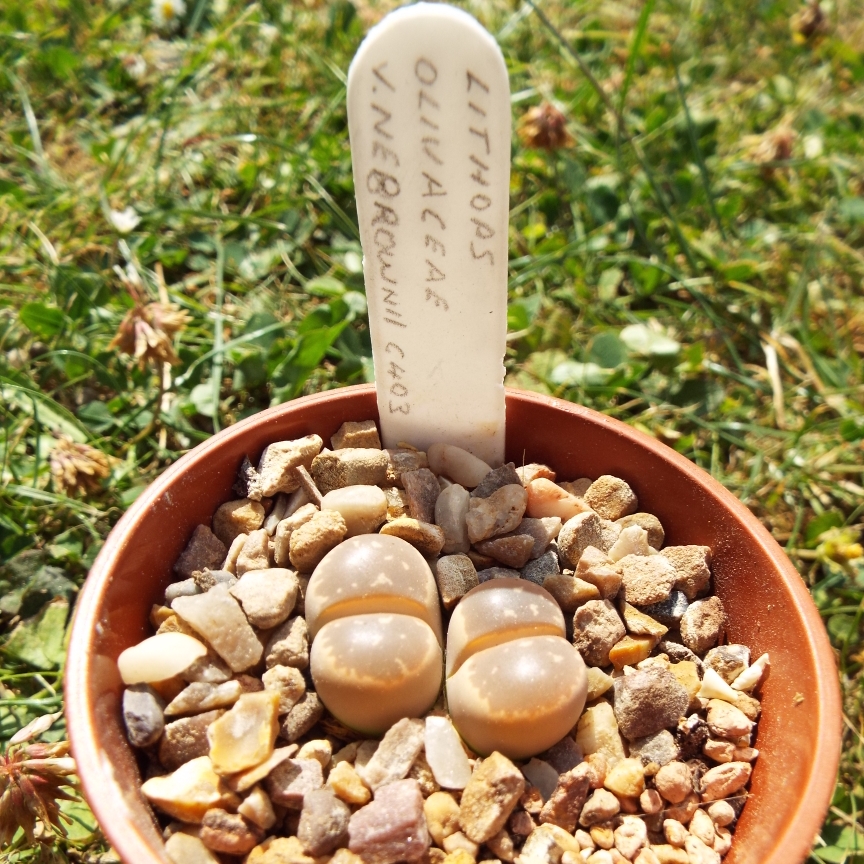
Lithops Olivaceae Nebrownii
Living Stones 'Olivaceae Nebrownii'
Original: Origin and Habitat: Lithops olivacea var. nebrownii are restricted and occur sporadically in in a small area to the South West of Aggeneys and near Aggeneys, thus at the South West end of the range of the species. Type locality: South West of Aggeneys. Habitat: It is a quartz lover and will always be found growing either on big outcrops of quartz or more commonly on quartz plains where the quartz pebbles protect the plants from the blazing summer sun by reflecting a lot of the light and heat. Stones comprises transluscent white and red-stained quartzite; opaque white quartzite stained with pink, red or rose quartz and feldspar flecked with mica. Ecology: Its hard translucent gloss closely resembles the white and red-stained quartz crystalline rubble of its habitat. Two succulent plant that are often found growing with Lithops olivacea var. nebrownii are Lithops julii subsp. fulleri anf Avonia papyracea, which loves quartz too. In times of drought the plants shrivel and are almost invisible, as they get covered with fine wind-blown sand. After rain, however, they absorb water and become fat and turgid. There is a considerable correlation between the colour of different populations and the nature of their habitats. New:A popular and sought after succulent. Lithops have paired leaves with smooth flat or rounded tops that are ridged or wrinkled, sometimes with transparent windows, and sometimes colorful markings. The flowers are white or yellow and emerge in autumn or winter. Lithops are relatively easy to grow if given sufficient sun and a suitable well-drained soil.
Contributed by @MadKatrina
-
Full sun to partial shade
-
Very little water
-
Not Frost hardy
-
Light and free draining
Common name
Living Stones 'Olivaceae Nebrownii'
Latin name
Lithops Olivaceae Nebrownii
type
Succulent
family
Aizoaceae
ph
5.0 - 6.5 Acid - Neutral
Plant & bloom calendar
-
Best time to plant
full grown dimensions
 0.02 M
0.01 M
0.02 M
0.01 M
Lithops Olivaceae Nebrownii
Original: Origin and Habitat: Lithops olivacea var. nebrownii are restricted and occur sporadically in in a small area to the South West of Aggeneys and near Aggeneys, thus at the South West end of the range of the species. Type locality: South West of Aggeneys. Habitat: It is a quartz lover and will always be found growing either on big outcrops of quartz or more commonly on quartz plains where the quartz pebbles protect the plants from the blazing summer sun by reflecting a lot of the light and heat. Stones comprises transluscent white and red-stained quartzite; opaque white quartzite stained with pink, red or rose quartz and feldspar flecked with mica. Ecology: Its hard translucent gloss closely resembles the white and red-stained quartz crystalline rubble of its habitat. Two succulent plant that are often found growing with Lithops olivacea var. nebrownii are Lithops julii subsp. fulleri anf Avonia papyracea, which loves quartz too. In times of drought the plants shrivel and are almost invisible, as they get covered with fine wind-blown sand. After rain, however, they absorb water and become fat and turgid. There is a considerable correlation between the colour of different populations and the nature of their habitats. New:A popular and sought after succulent. Lithops have paired leaves with smooth flat or rounded tops that are ridged or wrinkled, sometimes with transparent windows, and sometimes colorful markings. The flowers are white or yellow and emerge in autumn or winter. Lithops are relatively easy to grow if given sufficient sun and a suitable well-drained soil.
Planting
From Early Spring TO Early Spring
Lithops thrive best in a coarse, well-drained substrate. Any soil that retains too much water will cause the plants to burst their skins as they over-expand. Plants grown in strong light will develop hard strongly coloured skins which are resistant to damage and rot, although persistent overwatering will still be fatal. Excessive heat will kill potted plants as they cannot cool themselves by transpiration and rely on staying buried in cool soil below the surface.
Propagation
From Early Spring TO Early Spring
Propagation of Lithops is by seed or cuttings. Cuttings can only be used to produce new plants after a plant has naturally divided to form multiple heads, so most propagation is by seed. Lithops can readily be pollinated by hand if two separate clones of a species flower at the same time, and seed will be ripe about 9 months later. Seed is easy to germinate, but the seedlings are small and vulnerable for the first year or two, and will not flower until at least two or three years old.








